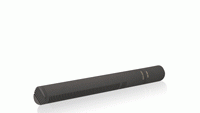New modular Sennheiser shotguns reflect user input

Among the new product offerings from Sennheiser are the MKH 8060 and MKH 8070, which together with the new MZD 8000 digital adapter represent a fresh technical update to the company’s line of shotgun microphones for studio and field production use. These mics are the product of extensive feedback and field testing from professional users.
Channel manager for professional systems Rob Blumenreder explained the development process. “The MKH 8000 modular series has been very successful for us. People love it,” he notes. “The introduction of the 8060 short shotgun and 8070 long shotgun adds new capabilities to that line. It also shows Sennheiser taking industry-standard products like the MKH 60 and MKH 70 shotguns and really improving them.”
The MKH 8060 is a short shotgun that measures 5.7in in length and weighs just 4oz when used with its XLR module, making it perfect for camera-mount and boom pool applications, while the MKH 8070 long version is ideal for sports broadcast, nature recording and other applications requiring high directivity. Both feature low inherent self-noise, high climatic resistance and low distortion with relatively high output voltage. Both microphones also benefit from a new interference tube design with a thinner diameter than previous Sennheiser designs, and also feature notably smaller preamplifier sections owing to advances in circuit board miniaturization.
The MKH 8000 modular family affords additional capabilities to these mics. When paired with the MZD 8000 digital module, the mics can transform into AES42-compliant digital microphones. The optional filter module, MZF 8000, adds a -10dB pad and roll-off filter, both switchable. Switching any MKH 8000 series microphone from analog to digital is as simple as unscrewing the XLR module and replacing it with the digital module.
“We did a lot of market research in developing these shotguns,” Blumenreder relates. “One of the common refrains we heard with the MKH 70 and 60 is that people love their flat response, but when you’re putting it inside a blimp with a hairy windscreen, you tend to lose the high frequencies. So on the 8060 and 8070, we’ve increased our high frequency response to compensate for that common production technique.”
He continues, “That brings us to a very basic principle about the MKH microphones. They utilize RF condenser technology. So we have an output stage that is impervious to the elements and is extremely quiet. The reason is that we don’t tension the diaphragm as much as a lot of other manufacturers. By having loosened that up, you’re not picking up as much of the air molecules moving, eliminating some of the ringing and resonance. So when the capsule is at its natural resonant frequency, you’re not dealing with all the self-noise issues. Of course, that changes the frequency response, so we electronically EQ that back to a more pleasing sound with a subtle rise on top.”
As for the sound, Rob Blumenreder is confident that Sennheiser’s extensive field testing and feedback from broadcast professionals has put both new shotguns in a good place, both in terms of on-axis response and off-axis naturalness. “We leave it up to the engineer’s ear,” he concludes. “I can say it’s fantastic off-axis response, but it’s different in character for short shotguns and long ones. For the engineer, the proof is in the pudding, and we’re confident that they’ll like what they hear when they plug in these microphones.”
Get the TV Tech Newsletter
The professional video industry's #1 source for news, trends and product and tech information. Sign up below.
